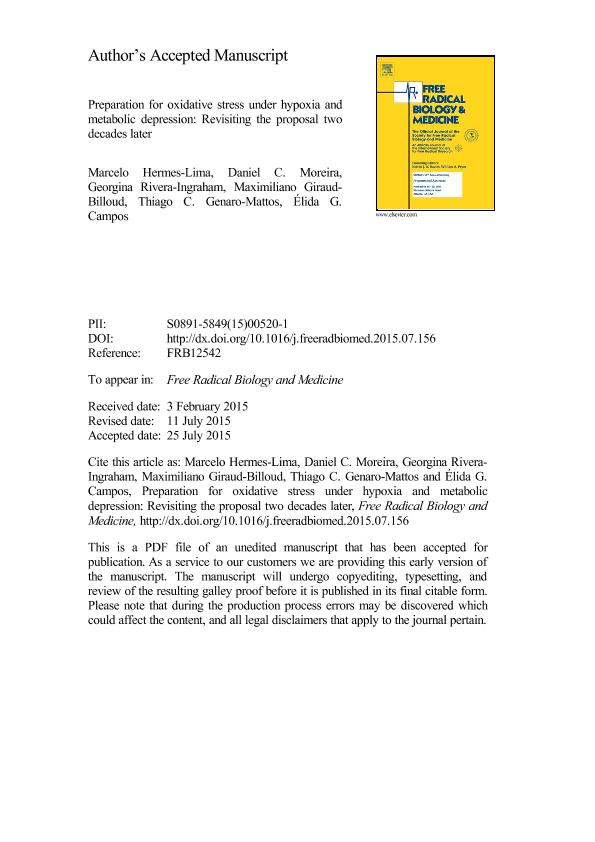Mostrar el registro sencillo del ítem
dc.contributor.author
Hermes Lima, Marcelo
dc.contributor.author
Moreira, Daniel C.
dc.contributor.author
Rivera Ingraham, Georgina A.
dc.contributor.author
Giraud Billoud, Maximiliano German

dc.contributor.author
Genaro Mattos, Thiago C.
dc.contributor.author
Campos, Élida G.
dc.date.available
2018-03-27T20:11:56Z
dc.date.issued
2015-12
dc.identifier.citation
Hermes Lima, Marcelo; Moreira, Daniel C.; Rivera Ingraham, Georgina A.; Giraud Billoud, Maximiliano German; Genaro Mattos, Thiago C.; et al.; Preparation for oxidative stress under hypoxia and metabolic depression: Revisiting the proposal two decades later; Elsevier Science Inc; Free Radical Biology and Medicine; 89; 12-2015; 1122-1143
dc.identifier.issn
0891-5849
dc.identifier.uri
http://hdl.handle.net/11336/40230
dc.description.abstract
Organisms that tolerate wide variations in oxygen availability, especially to hypoxia, usually face harsh environmental conditions during their lives. Such conditions include, for example, lack of food and/or water, low or high temperatures, and reduced oxygen availability. In contrast to an expected strong suppression of protein synthesis, a great number of these animals present increased levels of antioxidant defenses during oxygen deprivation. These observations have puzzled researchers for more than 20 years. Initially, two predominant ideas seemed to be irreconcilable: on one hand, hypoxia would decrease reactive oxygen species (ROS) production, while on the other the induction of antioxidant enzymes would require the overproduction of ROS. This induction of antioxidant enzymes during hypoxia was viewed as a way to prepare animals for oxidative damage that may happen ultimately during reoxygenation. The term preparation for oxidative stress (POS) was coined in 1998 based on such premise. However, there are many cases of increased oxidative damage in several hypoxia-tolerant organisms under hypoxia. In addition, over the years, the idea of an assured decrease in ROS formation under hypoxia was challenged. Instead, several findings indicate that the production of ROS actually increases in response to hypoxia. Recently, it became possible to provide a comprehensive explanation for the induction of antioxidant enzymes under hypoxia. The supporting evidence and the limitations of the POS idea are extensively explored in this review as we discuss results from research on estivation and situations of low oxygen stress, such as hypoxia, freezing exposure, severe dehydration, and air exposure of water-breathing animals. We propose that, under some level of oxygen deprivation, ROS are overproduced and induce changes leading to hypoxic biochemical responses. These responses would occur mainly through the activation of specific transcription factors (FoxO, Nrf2, HIF-1, NF-κB, and p53) and post translational mechanisms, both mechanisms leading to enhanced antioxidant defenses. Moreover, reactive nitrogen species are candidate modulators of ROS generation in this scenario. We conclude by drawing out the future perspectives in this field of research, and how advances in the knowledge of the mechanisms involved in the POS strategy will offer new and innovative study scenarios of biological and physiological cellular responses to environmental stress.
dc.format
application/pdf
dc.language.iso
eng
dc.publisher
Elsevier Science Inc

dc.rights
info:eu-repo/semantics/openAccess
dc.rights.uri
https://creativecommons.org/licenses/by-nc-nd/2.5/ar/
dc.subject
Anoxia
dc.subject
Dehydration
dc.subject
Estivation
dc.subject
Freeze Tolerance
dc.subject
Hypoxia Tolerance
dc.subject
Ischemia
dc.subject.classification
Otras Ciencias Biológicas

dc.subject.classification
Ciencias Biológicas

dc.subject.classification
CIENCIAS NATURALES Y EXACTAS

dc.title
Preparation for oxidative stress under hypoxia and metabolic depression: Revisiting the proposal two decades later
dc.type
info:eu-repo/semantics/article
dc.type
info:ar-repo/semantics/artículo
dc.type
info:eu-repo/semantics/publishedVersion
dc.date.updated
2018-03-27T13:36:16Z
dc.journal.volume
89
dc.journal.pagination
1122-1143
dc.journal.pais
Estados Unidos

dc.description.fil
Fil: Hermes Lima, Marcelo. Universidade do Brasília; Brasil
dc.description.fil
Fil: Moreira, Daniel C.. Universidade do Brasília; Brasil
dc.description.fil
Fil: Rivera Ingraham, Georgina A.. Groupe Fonctionnel Adaptation Ecophysiologique et Ontogenèse; Francia
dc.description.fil
Fil: Giraud Billoud, Maximiliano German. Consejo Nacional de Investigaciones Científicas y Técnicas. Centro Científico Tecnológico Conicet - Mendoza. Instituto de Histología y Embriología de Mendoza Dr. Mario H. Burgos. Universidad Nacional de Cuyo. Facultad de Cienicas Médicas. Instituto de Histología y Embriología de Mendoza Dr. Mario H. Burgos; Argentina
dc.description.fil
Fil: Genaro Mattos, Thiago C.. Universidade do Brasília; Brasil
dc.description.fil
Fil: Campos, Élida G.. Universidade do Brasília; Brasil
dc.journal.title
Free Radical Biology and Medicine

dc.relation.alternativeid
info:eu-repo/semantics/altIdentifier/doi/http://dx.doi.org/10.1016/j.freeradbiomed.2015.07.156
dc.relation.alternativeid
info:eu-repo/semantics/altIdentifier/url/https://www.sciencedirect.com/science/article/pii/S0891584915005201
Archivos asociados
